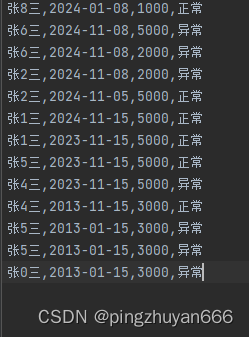全文目录,一步到位
1.前言简介
1.1 专栏传送门
1.1.1 上文传送门
=> python入门篇07-数据容器(序列 集合 字典,json初识)基础(下)
1.1.2 上文(数据容器)小总结
介绍了几种数据容器 以及相对应的api操作
应用场景以及基础小案例
2. python基础使用
2.0 数据容器总结进阶
2.0.1 数据容器表格对比
| 数据容器 | list列表 [] | tuple元组() | str字符串"" | set集合{} | dict字典{k:v} |
|---|---|---|---|---|---|
| 下标索引 | ✓ | ✓ | ✓ | ✗ | ✗ |
| 重复元素 | ✓ | ✓ | ✓ | ✖ | ✖ |
| 可否修改 | ✓ | ✖ | ✖ | ✓ | ✓ |
| 是否有序 | ✓ | ✓ | ✓ | ✖ | ✖ |
| while循环 | ✓ | ✓ | ✓ | ✖ | ✖ |
| for循环 | ✓ | ✓ | ✓ | ✓ | ✓ |
2.0.2 数据容器进阶操作
准备
测试案例代码
list1 = [1, 2, 3]
tuple1 = (1, 2, 3, 4, 5)
str1 = "abcdefg"
set1 = {
1, 2, 3, 4, 5}
dict1 = {
"key1": 1, "key2": 2}
-> (1) 长度: len() 方法
print(len(list1))
print(len(tuple1))
print(len(str1))
print(len(set1))
print(len(dict1))
-> (2) 最大值: max() 方法
print(max(list1))
print(max(tuple1))
print(max(str1))
print(max(set1))
print(max(dict1))
-> (3) 最小值: min() 方法
print(min(list1))
print(min(tuple1))
print(min(str1))
print(min(set1))
print(min(dict1))
-> (4) 容器转换list: list() 方法
print(list(list1)) # [1, 2, 3]
print(list(tuple1)) # [1, 2, 3, 4, 5]
print(list(str1)) # ['a', 'b', 'c', 'd', 'e', 'f', 'g']
print(list(set1)) # [1, 2, 3, 4, 5]
print(list(dict1)) # ['key1', 'key2']
-> (5) 容器转换元组: tuple() 方法
print(tuple(list1)) # (1, 2, 3)
print(tuple(tuple1)) # (1, 2, 3, 4, 5)
print(tuple(str1)) # ('a', 'b', 'c', 'd', 'e', 'f', 'g')
print(tuple(set1)) # (1, 2, 3, 4, 5)
print(tuple(dict1)) # ('key1', 'key2')
-> (6) 容器转换集合: set() 方法
print(set(list1)) # {1, 2, 3}
print(set(tuple1)) # {1, 2, 3, 4, 5}
print(set(str1)) # {'g', 'a', 'f', 'b', 'e', 'd', 'c'}
print(set(set1)) # {1, 2, 3, 4, 5}
print(set(dict1)) # {'key1', 'key2'}
-> (7) sorted排序: sorted() 方法
print(sorted(list1)) # [1, 2, 3]
print(sorted(tuple1)) # [1, 2, 3, 4, 5]
print(sorted(str1)) # ['a', 'b', 'c', 'd', 'e', 'f', 'g']
print(sorted(set1)) # [1, 2, 3, 4, 5]
print(sorted(dict1)) # ['key1', 'key2']
# 倒序 reverse默认是 false 正序
print(sorted(dict1, reverse=True)) # ['key2', 'key1']
2.0.3 字符串比较(ASCII编码)
与ASCII 数字对应的 American Standard Code for Information Interchange: American信息交换标准代码
# abd 与 abc比较
print('abd' > 'abc') # True
# a 与 A 比较
print('a' > 'A') # True
# ba 大于 ab 先比较第一位 然后再比较第二位 9897>9798
print('ba' > 'ab') # True
2.1 函数进阶 - 参数传递
2.1.1 设置多个返回值
def test_func():
return 1, 2, 3
# 看一种报错
# arg1, arg2 = test_func()
# print(arg1) # ValueError: too many values to unpack (expected 2)
arg1, arg2, arg3 = test_func()
print(arg1) # 1
print(arg2) # 2
print(arg3) # 3
print(test_func()) # (1, 2, 3) 元组
2.2 传参方式(多种)
2.1.0 代码准备
def test_func01(name, age, address):
print(f"名字:{
name},年龄:{
age},地址:{
address}")
2.1.1 方式一: 参数位置传递
test_func01("张三", 13, "地球")
2.1.2 方式二: 关键字参数传递
(这种类似 k-v结构 位置就
可以不对应了)
test_func01(name="张三", address="地球", age=13)
ps: 看一个
报错
TypeError: test_func01() missing 1 required positional argument: ‘age’
# test_func01(name="张三", address="地球")
2.1.3 方式三: 缺省参数传递
给参数设置默认值 不传递也可以
注意设置默认值的多个参数 都必须放到最后
test_func01(name="张三", address="地球", age=13)
测试代码+整体效果如下:
# 名字:张三,年龄:13,地址:地球
# 名字:张三,年龄:13,地址:地球
# 名字:张三,年龄:13,地址:火星
# 名字:张三,年龄:13,地址:中国
test_func02(age=13, name="张三")
test_func02("张三", 13)
test_func02(age=13, address="火星", name="张三")
test_func02("张三", 13, "中国")
2.1.4 方式四: 不定长参数传递
不定长参数(
类似java的可变参数)
不定长定义的形式参数作为元组存在 用 “*” 表示
def test_func03(*args):
print(args) # (1, 2, 3, 4)
print(type(args)) # <class 'tuple'>
test_func03(1, 2, 3, 4)
2.1.5 方式五: 关键字不定长参数传递
变成 字典 用 “
**” 表示
java没有此写法 直接传递map
def test_func04(**kwargs):
print(kwargs) # {'age': 12, 'name': '张三'}
print(type(kwargs)) # <class 'dict'>
test_func04(age=12, name="张三")
2.3 函数参数传递
这个有点意思, 也就是把
动作行为装成参数进行传递了
2.3.1 正常写法
参数传递的是函数 参数名随便写 也就是将
函数运算过程(不是参数) 传递进去
def test_func01(test_func):
result = test_func(1, 2)
print(type(test_func)) # <class 'function'>
print(result) # 3
def test_func02(arg1, arg2):
return arg1 + arg2
test_func01(test_func02) # 3
2.3.2 lambda匿名函数写法
对上面函数进行改造 (
一行代码lambda,多行使用def)
test_func01(lambda x, y: x + y)
3. 基础语法总结案例
python入门篇09- 文件操作,函数, 包及模块的综合案例

4. 文章的总结与预告
4.1 本文总结
函数的不同传递方式, 使用更加灵活
作者pingzhuyan 感谢观看